- Yokohama-shi Top Page
- Living and Procedures
- Community Development and Environment
- Rivers and sewers
- Sewer
- Disaster prevention and disaster countermeasures
- Earthquake countermeasures for sewerage facilities
Here's the text.
Earthquake countermeasures for sewerage facilities
Last Updated December 22, 2023
Yokohama's sewerage facilities (11 Water Reclamation Center, 2 Sludge Recycling Center, 26 Pumping Station) have a huge amount of assets of about 1 trillion yen, and many of them are based on seismic design guidelines that were old in the Showa era. It is constructed based on
Most of these sewerage facilities are built underground, so if you are damaged by an earthquake, it will take a long time to recover, and once the function is stopped, toilets will not be available, or untreated sewage will flow into rivers and seas, which can have a significant impact on the sanitary living environment and socio-economic activities of citizens.
However, it takes a lot of time and money to make all of these facilities earthquake-resistant.
Therefore, we identify important factors (bottlenecks) that may take time and effort to restore and may constrain recovery, promote priority earthquake countermeasures, and resume sewerage services as soon as possible even in the event of a large-scale earthquake. I will try.
Efforts for Earthquake Countermeasures
In the event of a large-scale earthquake, priority earthquake countermeasures based on the Business Continuity Plan (BCP) for sewerage facilities in order to shorten the period required for restoration and improve the treatment function immediately after the disaster, even in the event of a large-scale earthquake. I will proceed.
In order to enable simple treatment (pumping, sedimentation, disinfection) of the entire amount of inflow sewage even in the event of a disaster, we will promote measures such as earthquake resistance of pumping facilities that pump sewage.
In order to enable the incineration of all sludge even in the event of a disaster, we will promote measures such as earthquake resistance of sludge digestion tanks.
Information on earthquake countermeasures currently underway is provided.
Seismic reinforcement of Hokubu Sludge Treatment Plant sludge digestion tank (PDF: 1,275KB)
Seismic reinforcement of Nambu Sludge Treatment Plant sludge digestion tank (PDF: 2,194KB)
☆The minimum necessary sewage treatment must be continued even in the event of a large-scale earthquake.
The Business Continuity Plan (BCP) for sewage treatment facilities identifies businesses that should be prioritized under the situation where sewage treatment facilities have deteriorated due to a large-scale earthquake, etc. As shown in the figure below, the plan aims to shorten the period required for recovery of operation and improve the operation level immediately after the disaster, and minimize the impact on citizens' lives and lives.
Under the BCP, it is necessary to promote “disaster prevention measures (earthquake resistance in terms of the structure of facilities)” so as not to lower the operational level immediately after a disaster occurs, and to implement “reduce disaster damage Measures (provisional measures to enable prompt emergency response after a disaster)” to promptly restore operational level after a disaster occurs.
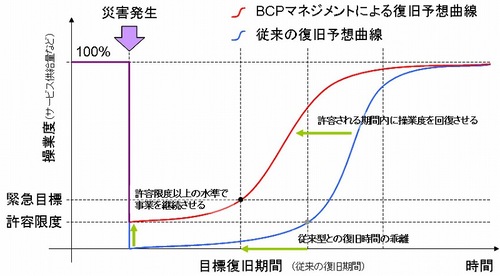
Expected restoration curve
Degradation of functions in sewage treatment facilities may have a significant impact on public health and socio-economic activities due to the inability of toilets and the outflow of untreated sewage, so take measures against earthquakes based on BCP. is needed.
☆We aim to implement simple processing in the event of a disaster.
If each water reclamation center secures approximately one series, pumping function, sedimentation function, and disinfection function, even in the event of a large-scale earthquake, the total amount of simple treatment (precipitation / disinfection) can be carried out.
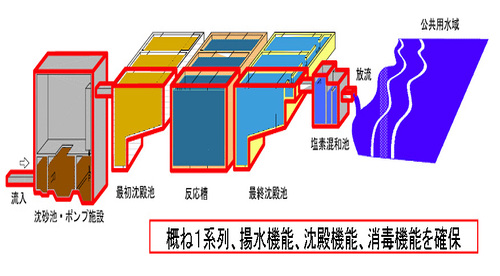
Implementation of simple processing
Therefore, in order to realize simple treatment in the event of a disaster, we will promote the earthquake resistance of pumping facilities and the earthquake resistance of chlorine mixing ponds (disinfection facilities). In addition, we will promote the earthquake resistance of in-tub expansion joints at water treatment facilities (first sedimentation pond, reaction tank, final sedimentation pond).
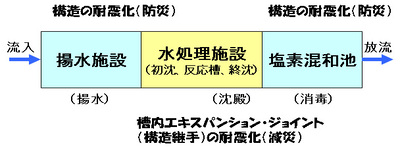
BCP for water treatment systems
☆Continuation of sludge treatment is essential for the continuation of sewage treatment.
Sewage treatment consists of water treatment and sludge treatment, as shown in the figure below, and the sludge treatment function that treats sludge generated during the sewage treatment process is an essential function for water treatment.
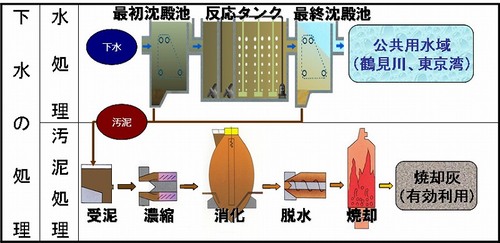
Flow of water treatment and sludge treatment
In the event of a disaster, if a large amount of concentrated sludge or dewatered sludge that cannot be processed is generated, it is difficult to secure a disposal site, and sewage sludge contains a large amount of water and organic content, so the surrounding environment and public health due to bacteria and odors It is a big problem.
Therefore, in order to realize the incineration of all sludge in the event of a disaster, we will promote the earthquake resistance of mud receiving facilities and sludge digestion tanks.
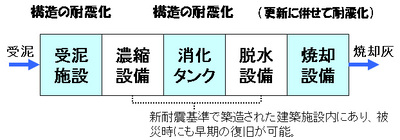
BCP for sludge treatment
You may need a separate PDF reader to open a PDF file.
If you do not have it, you can download it free of charge from Adobe.
![]() To download Adobe Acrobat Reader DC
To download Adobe Acrobat Reader DC
Inquiries to this page
Sewer River Bureau Sewerage Facilities Department Facility Maintenance Section
Telephone: 045-671-2850
Telephone: 045-671-2850
Fax: 045-550-3924
Email address: gk-shisetsuseibi@city.yokohama.lg.jp
Page ID: 548-447-968







